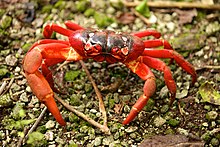Christmas Island red crab
| Christmas Island red crab | |
|---|---|
 |
|
| Scientific classification | |
| Kingdom: | Animalia |
| Phylum: | Arthropoda |
| Subphylum: | Crustacea |
| Class: | Malacostraca |
| Order: | Decapoda |
| Infraorder: | Brachyura |
| Family: | Gecarcinidae |
| Genus: | Gecarcoidea |
| Species: | G. natalis |
| Binomial name | |
|
Gecarcoidea natalis Pocock, 1888 |
|
 |
|
| Distribution map to Christmas Island red crab | |
The Christmas Island red crab (Gecarcoidea natalis) is a species of land crab that is endemic to Christmas Island and the Cocos (Keeling) Islands in the Indian Ocean. Although restricted to a relatively small area, it has been estimated that 43.7 million adult red crabs once lived on Christmas Island alone, but the accidental introduction of the yellow crazy ant is believed to have killed about 10–15 million of these in recent years. Christmas Island red crabs are well known for their annual mass migration to the sea to lay their eggs in the ocean.
Christmas Island red crabs are rather large crabs with the carapace measuring up to 116 millimetres (4.6 in) wide. The claws are usually of equal size, unless one becomes injured or detached, in which case the limb will regenerate. The male crabs are generally larger than the females, while adult females have a much broader abdomen (only apparent above 3 years of age) and usually have smaller claws. Bright red is their most common color, but some can be orange or the much rarer purple.
Like most land crabs, red crabs use gills to breathe and must take great care to conserve body moisture. Although red crabs are diurnal, they usually avoid direct sunlight so as not to dry out. Despite lower temperatures and higher humidity, red crabs are almost completely inactive at night. Red crabs also dig burrows to shelter themselves from the sun and will usually stay in the same burrow through the year. During the dry season, they will cover the entrance to their burrows with a loose wad of leaves to maintain high humidity in their burrow and will virtually disappear for 3 months until the start of the wet season. Apart from their breeding season, Red crabs are solitary animals and will defend their burrow from intruders.
...
Wikipedia
